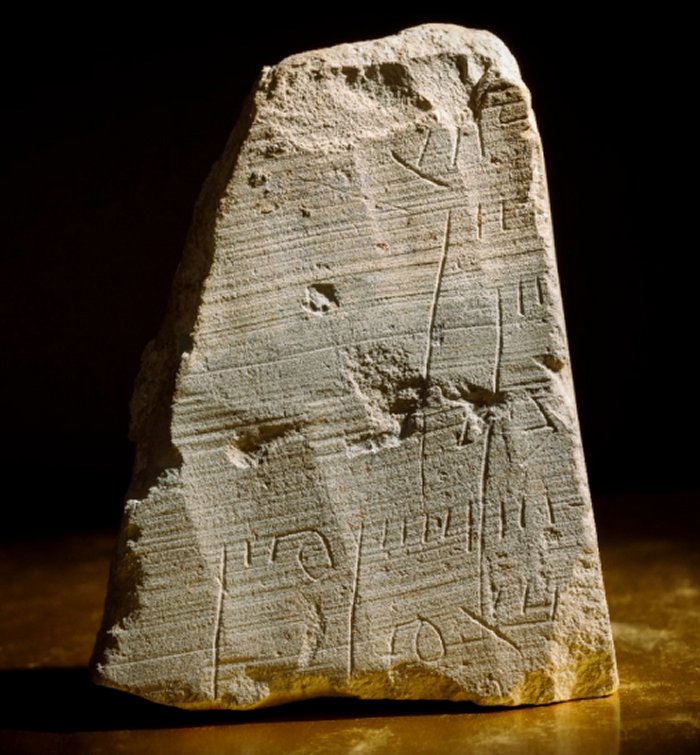Conny Waters – MessageToEagle.com – In excavations carried out on behalf of the Israel Antiquities Authority in the City of David, within the Jerusalem Walls National Park, and funded by the City of David Foundation, a small fragment of a stone tablet was discovered, bearing an inscription that was produced for financial purposes.
Photography: Kobi Harati, Eliyahu Yanai, City of David. Source: Israel Antiquities Authority
In a recent article published in the archaeological journal ‘Atiqot’ by Nahshon Szanton, Excavation Director on behalf of the Israel Antiquities Authority, with Epigraphist, Prof. Esther Eshel of Bar Ilan University, it is noted that four other similar Hebrew inscriptions have been documented so far in Jerusalem and Bet Shemesh, all marking names and numbers carved on similar stone slabs and dating to the Early Roman period.
This, however, is the first inscription to be revealed to date within the boundaries of the city of Jerusalem at that time.
According to the researchers, the inscription was carved with a sharp tool onto a chalkstone (qirton) slab. Apparently, the stone slab was originally used as an ossuary (burial chest), commonly used in Jerusalem and Judea during the Early Roman period (37 BCE to 70 CE). Ossuaries are generally found in graves outside the city, but their presence has also been documented inside the city, perhaps as a commodity sold in a local artisan’s workshop or store.
The seven partially preserved lines of the inscription include fragmentary Hebrew names with letters and numbers written beside them. For example, one line includes the end of the name ‘Shimon’ followed by the Hebrew letter ‘mem’, and in the other lines are symbols representing numbers.
Photography: Kobi Harati, Eliyahu Yanai, City of David. Source: Israel Antiquities Authority
Some of the numbers are preceded by their economic value, also marked with the Hebrew letter ‘mem’, an abbreviation of ma’ot (Hebrew for ‘money’), or with the letter ‘resh’, an abbreviation of ‘reva’im’ (Hebrew for ‘quarters’).
The intriguing find was discovered in the lower city square, located along the Pilgrimage Road. This Road, extending some 600 meters, connected the city gate and the area of the pool of Siloam in the south of the City of David, to the gates of the Temple Mount and the Second Temple, and essentially served as the main thoroughfare of Jerusalem at the time. This unique discovery joins similar findings uncovered in the area, attesting to the commercial nature of the area
The stone tablet, on which the inscription was engraved, was retrieved from a tunnel of a previous excavation at the site, dug at the end of the 19th century by British archaeologists, Bliss and Dickie, who excavated tunnels and pits along the Stepped Street. Although the inscription was found out of its original archaeological context, it was possible to date it to the Early Roman period, at the end of the Second Temple period, based on the type of script, the type of stone slab and its similarity to other contemporary inscriptions.
Rendering of the Pool of Siloam and the pilgrimage road, Second Temple period. Credit: Shalom Kveller, City of David Archives.
According to the researchers, “the everyday life of the inhabitants of Jerusalem who resided here 2,000 years ago is expressed in this simple object. At first glance, the list of names and numbers may not seem exciting, but to think that, just like today, receipts were also used in the past for commercial purposes, and that such a receipt has reached us, is a rare and gratifying find that allows a glimpse into everyday life in the holy city of Jerusalem”.
According to Szanton and Prof. Eshel, “The combination of the architectural and tangible space of the huge, paved stones of the square that were preserved at the site, and the discovery of small finds in this area, such as the measuring table and the new inscription, allow us to reconstruct parts of the incredibly unique archaeological puzzle in one of the vibrant centers that existed in ancient Jerusalem. Each piece of information, and certainly an ancient inscription, adds a new and fascinating dimension to the history of the city”.
Eli Escusido, Director of the Israel Antiquities Authority, commented on the discovery, saying that “the Pilgrimage Road, which is continually being uncovered in the City of David National Park in Jerusalem, is a flagship project of the Israel Antiquities Authority. It is not a coincidence that the many discoveries which are being revealed in the excavation shed light on the centrality of this road even during the Second Temple period. With every discovery, our understanding of the area deepens, revealing this street’s pivotal role in the daily lives of Jerusalem’s inhabitants 2,000 years ago”.
Written by Conny Waters – MessageToEagle.com – AncientPages.com Staff Writer








